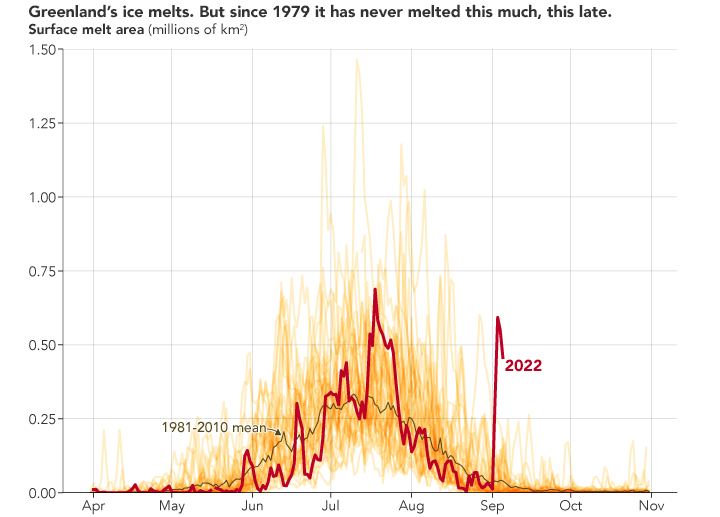

In September 2022, vast areas atop the Greenland ice sheet melted. Some scientists think the widespread late-season melting—the most on record for any September—could have implications for the ice sheet next year.
Greenland’s melting season typically runs from May to early September. The 2022 season started slowly, as lower-than-average air temperatures in May and June culminated in the least amount of spring melting in a decade. Melting continued at a modest pace throughout the summer, with a surge in mid-July. At its peak on July 18, surface melting spanned 688,000 square kilometers (266,000 square miles) of the ice sheet.
A late-season warm spell brought a substantial melting event from September 1–6. At its peak on September 3, melting occurred across 592,000 square kilometers of the ice sheet—the second-largest melting spike of the 2022 season and the largest for any September since the start of record-keeping in 1979. Melt events of this magnitude are unlikely in September because seasonal temperatures usually drop as the hours of sunlight decrease.

But unlikely does not mean impossible. The melting in September 2022 was the result of a weather system that brought warm, wet air over the ice sheet. The map at the top of this page shows how air temperatures from August 30 through September 5, 2022, compared with temperatures from the same period in 2020, when melting was more typical. Temperatures in some places soared 15°C (27°F) higher than in 2020. At the National Science Foundation’s Summit Station, temperatures were reported to be above freezing (0°C/32°F).
The map was derived from the Goddard Earth Observing System (GEOS) model and represents air temperatures at 2 meters (about 6-7 feet) above the ground. Modeled data, which uses mathematical equations that represent real-world physical processes, offer a broad, estimated view of a region where ground-based weather stations are sparse.
About 1.7 million square kilometers (656,000 square miles) of Greenland is covered with ice—the planet’s largest ice sheet outside of Antarctica. The ice gains mass through the accumulation of snow and loses it through surface melting and runoff, iceberg calving, and melting at the bottom of tidewater glaciers. As air and water temperatures have risen in recent decades, ice losses have outpaced gains, contributing to sea level rise.
According to Lauren Andrews, a glaciologist with NASA’s Global Modeling and Assimilation Office, melting events like the one in early September 2022 can affect current and future ice losses.
“When the melt season extends beyond its typical duration, the total amount of mass lost during the melt season obviously increases,” Andrews said. “But what isn’t so obvious is that a longer melt season also delays surface snow accumulation. This can, in turn, impact the initial intensity of the subsequent melt season.”
Less snow accumulation in winter means the snow can melt away more quickly in spring and expose large swaths of comparatively dark, bare ice. Compared with bright new snow, these darker surfaces absorb more solar energy, which amplifies melting during the Arctic’s long sunlit days.
NASA Earth Observatory images by Joshua Stevens, using GEOS-5 data from the Global Modeling and Assimilation Office at NASA GSFC and data from the National Snow and Ice Data Center. Science review by Christopher Shuman (NASA GSFC/UMBC JCET). Story by Kathryn Hansen.